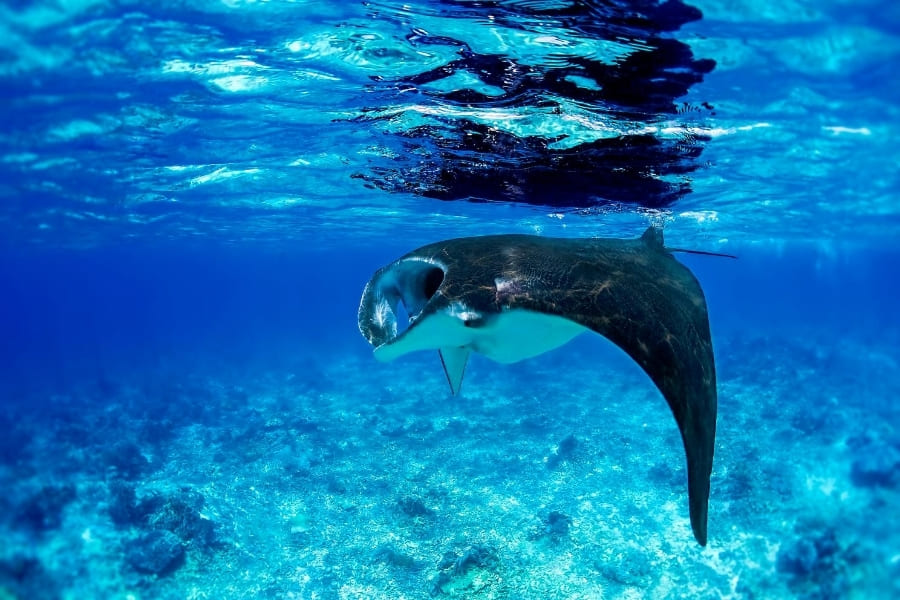They spend their lives well hidden in the sand off Florida’s coast, but also in coral reefs, open waters, and even in the deep sea – rays. For millions of years, these sea creatures have developed some remarkable feats and conquered countless habitats.
While divers and snorkelers are actively looking for these fish, many beachgoers are afraid to step on a stingray. In this article, we will tell you how to avoid unwanted encounters and what to keep in mind when dealing with rays.
You will also learn more about the best places to observe rays and swim with them – whether in the wild or at Florida’s zoos and aquariums.
Facts about Rays
Rays are fascinating creatures, and much about them is still unknown. What scientists do know, however, paints the picture of a highly complex group of animals. Here are the most important facts about rays:
Evolution
Just like their close relatives, the sharks, rays have been roaming our oceans since prehistoric times. As cartilaginous fish, they only leave few fossil traces, so their origins have not been fully discovered yet. However, researchers believe that rays as we know them evolved 150 million years ago – from a species similar to today’s guitar fish.
Species
Worldwide, there are more than 600 species of rays. About 15 of them live in the waters around Florida where they can be found in coastal areas, reefs and the open sea, but also in brackish and even fresh water:
- A common species is the Atlantic stingray. Well camouflaged, these rays wait in the sand until prey approaches, and then strike with their barbed tail.
- Dotted eagle rays are among the most interesting sights on any diving trip. They reach up to 11 feet in length and can often be seen in shallow waters and coral reefs.
- Electric rays have a special trick up their sleeves: This coastal species stuns its prey with electric shocks of up to 37 volts.
- With a maximum wingspan of 23 feet, giant mantas hold the record among rays. Since they swim slowly and close to the surface, they can easily be observed by divers.
- Devil rays are sometimes spotted on boat trips, as this species is known to jump out of the water.
- Thanks to their long, spiked snout, smalltooth-sawfish are unmistakable. With this tool, the fish stir up the sand to find prey.
Characteristics
The most dominant feature of all rays is their flat body shape. The pectoral fins are attached to the head, while the mouth is located on the bottom.
But why are rays so flat, you might ask? This physique has evolved over millions of years and helps the fish glide over the seabed. Since rays whirl up a lot of sand in the process, they have spiracles on the top, with which they filter oxygen from the water.
The eyes also sit on top of the body. Seeing, however, is not a ray´s most important sense. Instead, the animals detect their prey with the help of pressure waves and electrical impulses. Additionally, many species have developed a keen sense of smell.
In order to protect themselves from predators, rays resort to very different strategies: Some species dig deep into the sand; others use camouflage or quickly swim away in case of danger. Stingrays, on the other hand, defend themselves with a venomous barb on their tailfin.
By the way: It might not be obvious at first glance, but rays are closely related to sharks. Not only are both groups cartilaginous fish. Rays also possess a shark-like groove structure that helps to reduce water resistance.
Habitat
Our planet is home to more than 600 species of rays that populate a wide variety of habitats. Some species live in shallow coastal waters, while others can dive to depths of up to 2 miles. Rays prefer the warm and temperate zones, but have also conquered colder oceans like the North Sea. Some specimens, including the South American stingrays, even live in brackish and fresh water.
Diet
The diet of most ray species consists of mussels, crabs, starfish and sea urchins as well as fish. An exception is the giant manta. This species mainly eats plankton near the water surface. Recently, however, mantas were also seen diving to great depths in order to hunt fish and crabs.
Freshwater rays, on the other hand, predominantly feed on snails, worms, insects and jellyfish.
Reproduction
The reproduction patterns of rays fall in two categories:
Some rays lay capsule-shaped eggs that are surrounded by a gelatinous mass. Through slits in the eggs, the embryos are supplied with oxygen. 4 to 14 months after egg deposition, the babies hatch.
All other species of rays, such as giant mantas, give birth to live young. Right from the start, the little rays must fend for themselves. Therefore, females prefer to give birth in protected areas such as coral reefs, where their offspring can hide from predatory fish.
Endangerment and Protection
Unfortunately, human activity has had a huge effect on the ray population. Not only are these fish affected by polluted seawater, climate change and the vanishing of coral reefs. Many rays are also injured by fishing hooks and nets, with overfishing posing a serious threat.
A particularly worrying case is the endangered manta ray. Hunting these majestic giants is forbidden in Florida. Nevertheless, fishermen sometimes injure manta rays by accident when hunting for their companions, the cobias.
Other species that are protected in Florida include devil rays, dotted eagle rays, and smalltooth-sawfish
Rays in Florida – Dangers for Humans
Rays are shy animals that do not deliberately attack humans. However, there is one species that can be dangerous for beachgoers:
Stingrays populate the entire coast of Florida, where they burrow into the sand lurking for prey. When they feel threatened, these fish can sting with their barbed tail. This is not only painful and causes a deep, bleeding wound. Stingrays are also venomous. Although getting stung in the leg or foot is rarely enough to kill an adult person, the venom can cause allergy sufferers to have an anaphylactic shock, which can lead to organ failure.
Still more dangerous are stings in the abdominal and heart area – as can be seen in the most prominent ray victim: the “Crocodile Hunter” Steve Irvin.
Luckily, you can avoid this risk by making your presence known to rays before they sting. Floridians call this the “Stingray Shuffle”: When walking into the water, gently push your feet forward, whirl up a lot of sand and avoid big steps. This way, the ray knows that danger is approaching and has the chance to escape.
Should you see a group of rays coming towards you while swimming, it is best to stay calm. Avoid hasty movements, let the fish swim by and slowly “shuffle” out of the water.
Most stingrays can be found in the summer months when water temperatures reach their maximum. Particularly affected are the beaches of Clearwater, Cocoa Beach and Destin. However, all beaches in Florida can harbor stingrays, so you should always reckon with the animals.
Observe Rays in Florida – the best Places
In the Wild
If you want to observe rays in the wild, for example on a boat tour or while diving, we can recommend the following places:
Florida Keys
These barrier islands in southern Florida rank among the best dive sites in the USA. Therefore, it is not surprising that rays can be found in abundance here.
In addition to several species of stingrays, you also have the chance to see large manta rays gliding through the water. Recently, most sightings have been reported from Islamorada and the French Reef near Key Largo, while Molasses Reef is famous for its dotted eagle rays. Sometimes, these animals can be seen in sunken ships – even if they prefer to swim near the surface.
Everglades
In southern Florida, where the “river of grass” makes its way into the sea, mangroves provide an ideal refuge for stingrays. You can see these animals on a snorkeling trip – but thanks to their camouflage, you will need a keen eye and considerable luck. Located south of Everglades City are the Ten Thousand Islands. This world-famous freshwater dive site is a refuge for rays, and also offers excellent visibility underwater.
Southeastern Coast of Florida
While smaller species of rays are a common sight throughout the state, divers need more luck to see giant manta rays. This could change soon, though, as scientists suspect a breeding ground of manta rays in south-east Florida. The exact location has not been confirmed yet as these fish lead a nomadic life. However, with the manta rays swimming near the coast, they have even been spotted from beach houses in Miami.
Captiva and Sanibel Island
Every year, these islands near Cape Coral are home to a remarkable sight. Then, hundreds of cownose rays swim close to the beach – probably attracted by the warm temperatures. Like stingrays, cownose rays have a barbed tail for defense. They are less venomous, however, do not attack swimmers on purpose and are constantly on the move. Thus, the risk of accidents is small.
If you want to behold this “Stingray Fever”, you should visit Captiva and Sanibel Island in spring: between February and May, depending on the year.
In Captivity
In order to see rays in the Sunshine State, you do not need a diving license. Instead, you can get close to these animals in Florida’s zoos and aquariums:
- Four species are at home in the Jacksonville Zoo and Gardens – including guitar fish that resemble both rays and sharks.
- At the Florida Aquarium, visitors can pet stingrays in a tank. Do not worry – the animals do not possess venomous barbs anymore. In addition, you can admire majestic manta rays as you walk through a glass tunnel.
- The Miami Seaquarium also offers encounters with rays – either in the shallow touch pool or in a deeper pool where the rays share their habitat with nurse sharks.
- At Orlando’s Discovery Cove, you can feed Atlantic cownose rays and stingrays while wading in knee-deep water.
- A perfect place to marvel at the largest species of rays is SeaWorld, Orlando. There, manta rays glide through an aquarium that closely resembles a coral reef.
- If you want to interact with rays in their natural habitat, we recommend Dolphin World on Key West. There, the animals populate a sandy lagoon, together with many colorful fish. Please note that this animal encounter is only suitable for swimmers.
FAQ – Frequently Asked Questions
Which rays live in Florida?
Florida is home to about 15 different species of rays – including stingrays, dotted eagle rays, devil rays and giant manta rays, the largest species of all.
Are there manta rays in Florida?
Yes, with a bit of luck you can see this ray species off the Florida coast. Mantas prefer to stay in coral reefs, for example in the Florida Keys. Recently, however, they have also been spotted off the southeastern coast near Miami.
Are rays in Florida dangerous?
Stingrays, which populate the entire Florida coast, can be dangerous for humans due to their venomous sting. The species only stings when it feels threatened. Therefore, it is advisable to carefully wade into the water and warn the animals with foot movements.
Is it legal to fish for rays in Florida?
In Florida, you can legally catch stingrays with a fishing rod or a net. However, there are protected species such as the giant manta, devil rays, eagle rays and smalltooth-sawfish that you are not allowed to catch.







